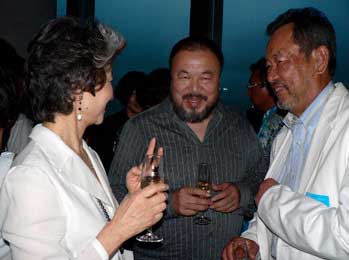
POSTERS PRONOUNCING AI WEIWEI THE MOST EVOCATIVE CREATOR IN CONTEMPORARY CHINA greeted me as I alighted through the Roppongi subway station last Friday at the end of a long journey from New York, having arrived in Tokyo just in time for the opening of Ai’s exhibition “According to What?” at the Mori Art Museum. As I checked into my hotel and changed, I pondered whether evocative had been a last-minute substitution for provocative—the latter would have been appropriate given Ai’s recent troubles with the law—or whether Japanese English just skews toward these sorts of poetic declarations. As with many things about Ai Weiwei, it’s an ambiguity best preserved.
The exhibition, organized by chief curator Mami Kataoka and spread across the Mori’s entire exhibition space, chronicles the breadth of Ai’s work more completely than any other to date. Mutations of Chinese “cultural readymades” like furniture and pottery lead to original riffs on those same forms, which lead to architectural models and grueling Warholian films in a familiar enough progression. The only major new piece was as much political manifesto as aesthetic investigation, and more provocation than evocation: An assemblage of backpacks hung from the ceiling in commemoration of the schoolchild casualties of last year’s Sichuan earthquake.
Ai huddled in the final gallery, receiving well-wishers until museum staff herded the crowd downstairs for a long round of speeches in translation. (For all their professed animosity, Japan and China share a common love for such prelection. In China, however, such ceremonies take place before the exhibition, and certainly not over champagne.) The crowd would erupt in waves of rowdiness, prompting the Mori’s dedicated shusher to action, a cause-and-effect familiar to anyone who had attended the opening of Francesca von Habsburg’s collection show a few months prior.
If you’ve never been to the Mori, or to the Roppongi Hills complex that it crowns, don’t believe the bit in Rem Koolhaas’s Content about the place titled “Pure Evil.” “A project of unmitigated awfulness that embodies, with seeming deliberation, a recapitulation of everything bad about twentieth century architecture,” he called it back in 2003, the year it opened. Sure, it’s a bland triumph of site-unspecific commercial architecture that harks back to an optimistic world in which lots of time was spent looking for wi-fi hot spots. But these days, that’s not such a bad moment to revisit, and as a staging of the anxieties (and guilty pleasures) of the globalized cultural-industrial complex, you really can’t beat the view from a museum on the fifty-third floor, in a building in which the opening dinner, conference, and hotel are all in spaces owned by the same family and accessible by the same elevator.
The scene at the Italian buffet dinner (Roppongi Hills Club, 51/F) that followed resembled a night in Ai’s now-shuttered restaurant, Qu Na’r, circa 2005. Each impromptu table constituted an orb of affinity and interest, with groups falling into and out of alignment as the night wore on. Everyone wanted a piece of the bearded master, who in turn preferred to crack jokes in Chinese to his lieutenants, all of whom were outfitted in Issey Miyake purchased during a “thank-you” shopping spree at the end of twelve days installing. Around the room were Ai’s dealers—Urs Meile, Christophe Mao, Cheryl Haines, Marc Benda—and auction-house folks like Phillips de Pury’s Chin Chin Yap and Jeremy Wingfield and Guardian’s Xiaoming Zhang. A few collectors were there, too—Uli Sigg, Hallam Chow, Larry Warsh, and Greg Liu—along with some museum people, including a MoMA delegation, of which newly minted curator Doryun Chong was a part. With unflagging precision, Kataoka announced the party’s imminent end at the fifteen-, ten-, and five-minute marks, giving just enough time to down an espresso and regroup for another outing on the plaza below, in the shadow (cast by a perfectly calibrated spotlight, twenty stories above) of a giant Louise Bourgeois spider.
Sunday (Academy Hills, 49/F) saw an eight-hour “interview marathon”—yes, it seems the Obristian coinage has entered the public domain—as six interlocutors (myself included) tag-teamed the artist with interpretations of his work, exhortations on their own, and, sometimes, good questions. Sigg led off with a condensed history of Chinese contemporary art, illustrated with images drawn entirely from his encyclopedic collection. Architect Kengo Kuma posed questions of “craftsmanship,” an issue that seemed to haunt the curatorial premise of the show upstairs. Artist Hiroshi Sugimoto, like Ai a self-taught architect, closed the day’s events with a lengthy encomium to his own recent projects, including a museum he designed and the first show—“naturally of my own work”—to be staged there. “Will there be a second show?” Ai rejoined.
Not surprisingly, the conversation often came back to Ai’s recent brush with the law that led to the closure of his much-loved blog in early June. He jovially recounted a tale of calling the Caochangdi village police station to report the secret agents who were staking out his home and studio and who refused to show him their badges. (One of the plainclothes turned out to be the brother of the local patrolman—so much for that plan.) Many speculate that the troubles owed ultimately to the “citizen’s investigation”—staffed by volunteers and mobilized via his blog—that canvassed the Sichuan disaster zone throughout the spring, collecting names and vital statistics on fifty-one hundred of the earthquake’s youngest victims. For Ai, the unresolved carnage—60 percent of parents have not been able to reclaim their children’s remains—owes much to shoddy school construction, and thus to party corruption. Under this pressure, the government released a figure of 5,335 dead schoolchildren just before the one-year anniversary of the May 12 quake. Asked point-blank by architect Shigeru Ban why he bothered to pursue this seemingly self-destructive personal campaign, Ai looked around at the hundreds of eyes fixed on him and replied bluntly, “If I don’t use my social privilege to do this, I feel ashamed.” | 